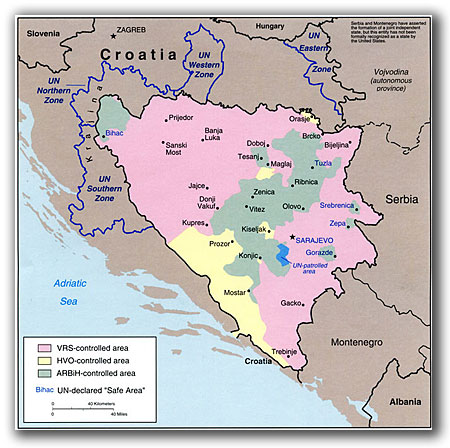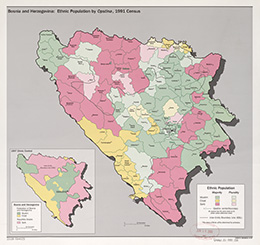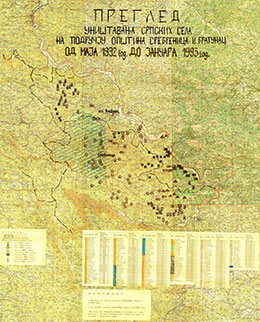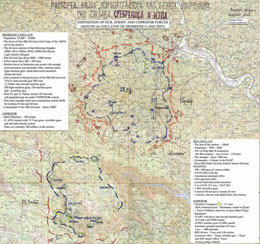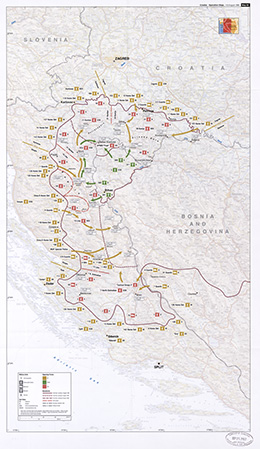IN THE NEWSInternational Decision-Making in the Age of Genocide: Srebrenica 1993-1995 Declassified U.N. Cables Reveal Turning Point in Rwanda Crisis of 1994 Genocide Under Our Watch Exclusive: Rwanda Revisited Results from Rwanda Conference Previous PostingsKey Decision Makers and Eyewitnesses Gather in the Hague to Consider the Failure of the International Community in the 1994 Rwandan Genocide "International Decision-Making in the Age of Genocide: Rwanda 1991-1994" The Secret History of Dayton: U.S. Diplomacy and the Bosnia Peace Process 1995 Lessons Learned from U.S. Humanitarian Interventions Abroad |
Interview of Srebrenica survivor Muhamed Durakovic 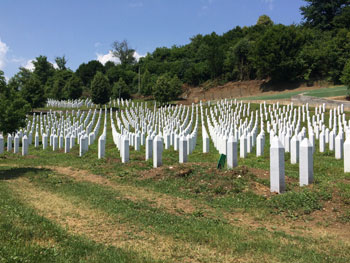
Grave markers at the Srebrenica-Potocari Memorial and Cemetery for the Victims of the 1995 Genocide – Source: Sarah Reichenbach, The Advocacy Project, June 2015. 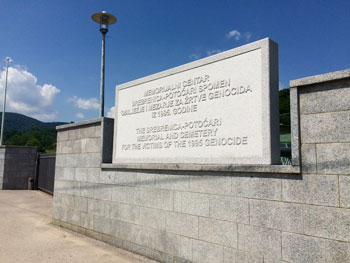
Srebrenica-Potocari Memorial and Cemetery for the Victims of the 1995 Genocide – Source: Sarah Reichenbach, The Advocacy Project, June 2015. 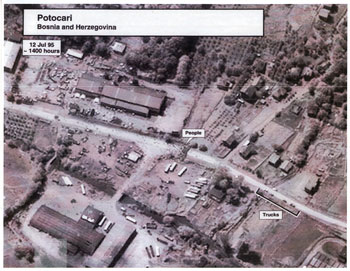 Potocari, Bosnia and Herzegovina, July 12, 1995 – Source: National Security Archive FOIA, U.S. National Geospatial Intelligence Agency 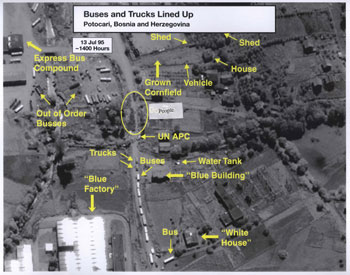 Buses and Trucks Lined Up: Potocari, Bosnia and Herzegovina, July 13, 1995 – Source: ICTY; U.S. National Geospatial Intelligence Agency. 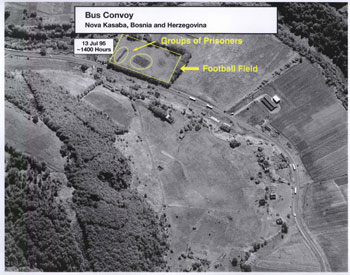 Bus Convoy: Nova Kasaba, Bosnia and Herzegovina, July 13, 1995 – Source: ICTY; U.S. National Geospatial Intelligence Agency. 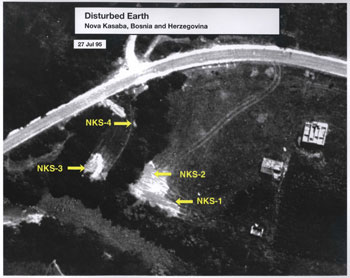 Disturbed Earth: Nova Kasaba, Bosnia and Herzegovina, July 27, 1995 - Source: ICTY; U.S. National Geospatial Intelligence Agency. 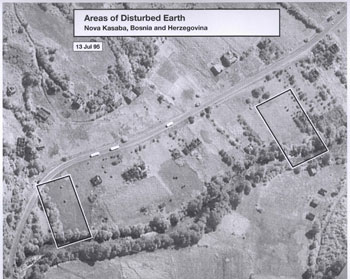 Areas of Disturbed Earth: Nova Kasaba, Bosnia and Herzegovina, July 13, 1995 - Source: ICTY; U.S. National Geospatial Intelligence Agency. 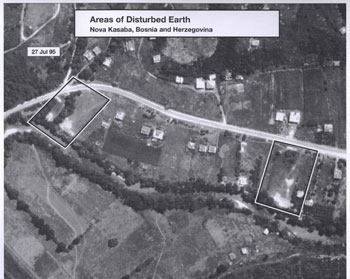 Areas of Disturbed Earth: Nova Kasaba, Bosnia and Herzegovina, July 27, 1995 - Source: ICTY; U.S. National Geospatial Intelligence Agency. 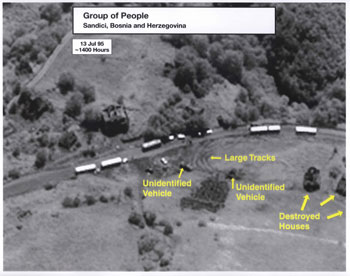 Group of People: Sandici, Bosnia and Herzegovina, July 13, 1995 - Source: ICTY; U.S. National Geospatial Intelligence Agency. .jpg) Overview: Potocari, Bosnia, July 12, 1995 - Source: ICTY; U.S. National Geospatial Intelligence Agency. The Hague, The Netherlands, July 1, 2015 – Debates in the United Nations and within UN staff and member states as early as March 1993 over the concept of so-called “safe areas” for Bosnians within the former Yugoslavia exposed deep contradictions between means and ends, capabilities and intentions, that culminated in the Srebrenica genocide of 1995, according to documents reviewed this week at the international conference marking the 20th anniversary of Srebrenica and posted today by the National Security Archive (https://nsarchive2.gwu.edu). The documents include the field report on the first declaration by a UN official, General Philippe Morillon, to the inhabitants of Srebrenica and refugees who had fled there to escape ethnic cleansing that they were “under the protection of the UN.” Other documents provide critiques of the concept of safe havens from the U.S. intelligence community and from the UN Secretariat, which argued for a “heavy option” of 30,000 or more troops, which at least one Security Council ambassador, David Hannay, took to be an attempt to undermine the whole idea of “safe areas”. The documents also feature extensive exchanges between UN headquarters and the UN forces in the field over how to carry out the Security Council’s resolutions, with one general in the field remarking that the UN decision to proceed with the “light option” meant the “safe areas” completely depended on the agreement of the parties to the conflict. The then-head of UN peacekeeping, Kofi Annan, remarked in one cable about demilitarizing the safe zones, that “In doing so, however, UNPROFOR takes on a moral responsibility for the safety of the disarmed that it clearly does not have the military resources to honor beyond a point.” The documents reflect the continuing insistence throughout 1993-1995 by senior officials such as Special Representative Yasushi Akashi and his senior military commanders, Gen. Bertrand de La Presle and Gen. Bernard Janvier, that UNPROFOR remain neutral and avoid taking action that might provoke confrontation – a mindset that would have fateful consequences in the dates leading up to Srebrenica. Also included in the documents are the arguments from Lt. Gen. Rupert Smith for more aggressive action to break the cycle in 1994 and 1995 of escalation and counter-escalation and retreat. One example Smith presented was of Bosnian Serbs taking UN personnel hostage in reaction to, and in order to prevent, air strikes. This posting is the first of a series from the Srebrenica conference briefing book. The conference organizers plan to publish the entire evidence base from the conference, along with a rapporteur’s report of findings and conclusions, and a final edited transcript of the discussion, which included Mr. Akashi, Gen. Smith, Lord Hannay, and 30 other eyewitnesses to international decision-making around the Srebrenica genocide.
Conference Participants
Yasushi Akashi, Special Representative to the UN Secretary-General to the former Yugoslavia (January 1994-October 1995) Diego Arria, Permanent Representative of Venezuela to the United Nations (1991-1993) Carl Bildt, appointed as European Union's Special Envoy to the former Yugoslavia in June 1994 Muhamed Durakovic, Srebrenica native and genocide survivor André Erdös, Permanent Representative of Hungary to the United Nations (1990-1994) Peter Galbraith, first United States ambassador to Croatia (1993-1998) David Hannay, Permanent Representative of the United Kingdom to the United Nations (1990-1995) David Harland, civilian affairs officer to the United Nations peacekeeping mission in Bosnia and Herzegovina from 1993-1998 and co-authored the 1999 United Nations report on the Srebrenica Massacre, "The Fall of Srebrenica." General Vere Hayes, Chief of Staff of UNPROFOR, and negotiated the Srebrenica “safe area” agreement between Bosnian government and Bosnian Serbs in April 1993. Larry Hollingworth, C.B.E. was appointed Chief of Operations in Sarajevo for the United Nations High Commission for Refugees in 1992. Henry Jacolin, French Ambassador to Bosnia (1993-1995) Colonel (ret.) Thom Karremans, Commanding Officer of Dutchbat III, which was deployed to Srebrenica in 1995 Obrad Kesic, is the Director of the Republika Srpska Office for Cooperation, Trade, and Investment in Washington, D.C. Wim Kok, Prime Minister of the Netherlands (1994-2002) Zlatko Lagumdžija, Deputy Prime Minister of Bosnia (1992-1993) General Kees Matthijssen, Company Commander for Dutchbat III stationed in Srebrenica in 1995 Hasan Muratovic, Bosnian Minister for UN Affairs (1992-1996) General Kees Nicolai, Chief of Staff of the UN Command in Bosnia from March to September in 1995 David Rohde, won the Pulitzer Prize for International Reporting in 1996 for his coverage on Srebrenica while a reporter for the Christian Science Monitor James Rubin, Senior Advisor and Spokesperson for US Ambassador to the United Nations, Madeleine Albright (1993-1996) John Shattuck, Assistant Secretary of State for Democracy, Human Rights, and Labor (1993-1998) General Rupert Smith, commander of UNPROFOR in 1995 Shashi Tharoor, led the team in the UN Department of Peacekeeping Operations that was responsible for the former Yugoslavia Joris Voorhoeve, Dutch minister of Defense (1994-1998) Jenonne Walker, Special Assistant to President Bill Clinton and Senior Director for Europe on the National Security Council Staff from 1994 to early 1995. UN High Commissioner Zeid Ra'ad Al Hussein, served as political affairs officer in UNPROFOR from 1994-1996 and Jordan's Deputy Permanent Representative to the United Nations (1996-2000), was appointed as the UN High Commissioner for Human Rights in September 2014.
Biographies of Conference Participants
* * * * *
THE DOCUMENTS[Documents marked with [NEW] are being made available to the public and published for the first time here. Thanks to Lord David Owen, General Vere Hayes, and General Kees Nicolai for the generous donation of selections of their personal papers to the National Security Archive.]
Document 1 In a report to UNPROFOR (United Nations Protection Force) Headquarters, British Major Piers Tucker writes that the UNPROFOR troops under General Philippe Morillon are “in Srebrenica” and “are not being permitted to leave” by local inhabitants after the troops received permission from the Serb Army to deliver humanitarian aid, breaking the siege of Srebrenica. The inhabitants and refugees in Srebrenica were concerned that when the UN troops left, the Serb Army would attack the majority Muslim enclave. While in Srebrenica, General Morillon declares that the refugees are “under the protection of the UN.” The UN flag is then raised over Srebrenica and the UNHCR organizes the evacuation of nearly 3,000 women, children, and old men. Document 2 This document from the intelligence community's monitoring task force is a sour assessment of the prospects for the establishment of safe havens, including their potential need for "a large infusion of Western forces" (known to be a non-starter), many more UN troops, liberal rules of engagement for those troops, and heavy defensive equipment– none of which was ever made available to the defenders of Srebrenica. Document 3 This documents reports on the agreement to demilitarize Srebrencia, which occurred the day before at a meeting in Sarajevo between Serb Army Lt. Gen. Ratko Mladic and Bosnian Gen. Sefer Halilovic, in the presence of United Nations Protection Force (UNPROFOR) mediator Lt. Gen. Lars-Eric Wahlgren. The main points of the agreement discuss details of the ceasefire, the deployment of UNPROFOR troops into Srebrenica, attention to the wounded in Srebrenica, and the demilitarization and disarmament of all inhabitants of the town. Document 4 Head of the Department of Peacekeeping Operations (DPKO) at the United Nations Kofi Annan writes to Lt. Gen. Wahlgren regarding the DPKO’s reaction to the establishment of the “safe area” in Srebrenica. Annan explains: “As we see it, the demilitarization of Srebrenica was a step agreed by the parties, not one proposed by the United Nations. Nonetheless, in order to save lives, UNPROFOR is lending its good offices to help both parties fulfil [sic] the commitments they have made to each other. This includes receiving weapons from the defenders of Srebrenica for the purpose of demonstrating to the attackers that they have no reason to attack. In doing so, however, UNPROFOR takes on a moral responsibility for the safety of the disarmed that it clearly does not have the military resources to honor beyond a point.” The document also includes clarifications on use of force for self-defense only, and that UNPROFOR should “not participate too actively in ‘disarming the victims’.” Document 5 Serb Army Lt. General Ratko Mladic writes in his diary of a meeting with UN Civil Affairs Officer in Sarajevo, Russia’s Victor Andreyev, regarding potential western and UN intervention in the conflict. Andreyev, with an insider’s view of the UN, assures Mladic that the chances of an intervention are lower because the US and Europe have not reached an agreement on it, and that Russia will not allow it. They continue to discuss strategies to strengthen Mladic’s position and agenda, as well as commenting on various personalities on the UN Security Council, and officers in United Nations Protection Force (UNPROFOR). In his concluding remarks, Andreyev comments that New York Times reporter “John Burns had the effect of 100,000 soldiers. Propaganda is a very powerful thing and it is strongly against the Serbs.” Document 6 [NEW] Annan presents a working paper circulated by Alvaro de Soto of the Department of Peacekeeping Operations (DPKO) to the UN Security Council to respond to questions regarding “safe areas” in general. This concept paper discusses definitions, legal issues, operational considerations, advantages, disadvantages, and a variety of other factors and logistical issues. The report contains annexes that describe the humanitarian situation in the “safe areas.” See David Hannay’s May 29, 1993 telegram regarding his views on this “safe areas” concept paper [Document 7]. Document 7 [NEW] Hannay writes about the UN Security Council's informal consultations regarding the “safe areas” resolution, and the Department of Peacekeeping Operations (DPKO) concept paper on the “safe areas”. Hannay writes that the concept paper on “safe areas” [Document 6] was “designed to lead to the conclusion that the idea is not viable.” He further wrote of the paper: “This paper…was not the factual report on the situation on the ground requested in the council consultations on 27 May… but instead a fully-fledged concept paper. It is moreover a heavily slanted paper, setting out a heavy option concept of “safe areas”, and undoubtedly designed to lead to the conclusion that the concept is not viable…We had asked for a factual situation report. We did not need to be told that the “safe areas” concept was a difficult one. We knew that. The council would have to take a decision on whether it was worth doing.” Hannay writes that French Representative to the UN Jean-Bernard Mérimée was “particularly incensed by a judgement in the paper that one disadvantage of “safe areas” was that they would ‘legitimize ethnic cleansing’. Hannay also writes of US Representative to the UN Madeleine Albright’s comments on the “safe areas” resolution, specifically on the arms embargo section. He writes that she wanted to make certain changes “so as to make it clearer that (US) intervention would be in support of UNPROFOR and not of the civilian population.” In the conclusions, Hannay comments: “Not a good day. The scandalously slanted secretariat paper circulated by de Soto was almost certainly the work of Tharoor, Annan’s special adviser for UNPROFOR, who is clearly keen to scotch the “safe areas” draft.” Hannay hopes for negotiations on the draft and an increased pace toward passing the resolution is expected for the following week. Document 8 [NEW] Lt. Gen. Wahlgren, UNPROFOR Force Commander, responds to Kofi Annan of DPKO in New York with his reactions to the UN Security Council draft on “safe areas”. He responds with concerns regarding the practicality of implementing the “safe areas”; the need to clarify UNPROFOR’s mandate, including use of force; and the consequences of the use of airpower. Wahlgren continues by requesting a change in mandate, and “a clear commitment of resources” in order for UNPROFOR to develop a “deployment plan and implementation time scale.” He suggests dividing the resolution into two steps: preparation, and then execution. In conclusion, he writes that, “One simply cannot make peace and war at the same time.” Document 9 [NEW] French General Bertrand de La Presle, who took over as Force Commander of UNPROFOR in March 1994, writes to Kofi Annan of DPKO at the United Nations in New York to clarify the definition of the “safe areas”, and UNPROFOR’s mandate with regard to carrying out the “safe area” resolutions 824 and 836 passed by the Security Council in May and June 1993, respectively. De La Presle recognizes that the resolutions were passed to protect civilian populations “from armed attacks or the denial of humanitarian aid,” and that “safe areas” are “represented by population centers, regardless of their size.” He writes, “Safe areas” can be imposed by either force, or agreement by warring parties.” He continues: “By choosing to adopt the ‘light option’ with the respect to force levels, the international community accepted that the “safe areas” would be established and defined by agreement as opposed to force. This choice was a clear rejection of a peacemaking or peace enforcement approach and an acceptance that the task would be achieved through peacekeeping means…UNPROFOR’s main deterrent capacity, rather than being a function of military strength, would essentially flow from its presence in the “safe area.’” De la Presle concludes by reiterating that this document is “an explanation of UNPROFOR’s understanding of the concept of “safe areas” as applies since the adoption of resolution 836,” and that “UNPROFOR will continue to use this same definition unless otherwise directed.” Document 10 John Menzies writes to the Secretary of State in Washington, DC about a conversation with UNPROFOR Force Commander Gen. Rupert Smith regarding the future of the UNPROFOR mission. Smith suggests that the “only question that matters” is: “are we going on through the pain barrier?” He questions if there is a willingness to continue the mission and being prepared for a fight - “cross the pain barrier” - or withdrawing the mission and not crossing the “pain barrier.” Smith explains that if there is a willingness to continue the mission it would require “bodies; a long term commitment; resources, 'money'; and a willingness to escalate,” and that he would need “a clear plan behind me as to where we’re going.” Menzies writes that if the choice was to “not cross the pain barrier,” then the mission would have to withdraw because it could not continue as it is. Menzies writes that Smith said that in either case, “the old conditions cannot be recreated, and the UN cannot pretend that it can operate under the existing mandates.” Menzies concludes with an ominous warning that “we believe that we are approaching perhaps the final crisis of the UNPROFOR mission in Bosnia.” Note: See Document 16 for continued argument regarding use of force between Smith and his superiors Gen. Janvier, UNPROFOR Force Commander, and Special Representative Akashi. Smith had a plan that would actually come to fruition with the Rapid Reaction Force in late August and early September that lifted the siege of Sarajevo, but it would be too late for Srebrenica. Document 11 In a memo from National Security Advisor Tony Lake to President Clinton, Lake recounts the Principals Committee meeting on May 28, 1995 at which top US officials discussed the use of US forces to assist with the withdrawal of UNPROFOR troops from Bosnia, and redeployment of the troops in other areas of the country. The Principals agreed on several basic points for US policy regarding: prospects for additional airstrikes; diplomatic efforts at the UN contact group; options and prospects for emergency withdrawal; and the future of UNPROFOR. In the recommendations, the principals concluded that “it is not in our interest to see the eastern enclaves abandoned,” and that “we should work…to ensure that adequate forces remain available to sustain a UNPROFOR presence in the enclaves.” A handwritten note at the end of the document, next to a check marking “approve”, says: “POTUS [President of the United States] is returning with a new note saying ‘I agree as you have set forth.’ 5/30, 8pm.” Note: Lake had been an advocate of air strikes throughout 1993 to 1995, but was stymied by Pentagon objections. Dutch Defense Minister Voorhoeve, reading this document, concludes this is the moment of betrayal of Dutchbat, when the US reneged on its commitments to defend the peacekeepers with air strikes. The US decision was for a pause, a plan for major strikes at the first Serb attack, and redeployment of the peacekeepers to keep them from becoming hostages again which would prevent future strikes. This plan was precisely what Rupert Smith had been advocating, and not at all a retreat in Lake's view. Document 12 [NEW] UNPROFOR Commander, Lt. Gen. Smith writes regarding the use of airstrikes, and the current situation of UNPROFOR troops. He reports that “some 247 UN personnel are hostage or in isolated detachments and surrounded by the BSA [Bosnian Serb Army],” and that “significant amounts of equipment and weapons have been taken.” He describes their situation where “UNPROFOR has used force to enforce a mandate. (There is now potential for confusion between force being used in self-defense and for enforcement.)” Smith writes: "I have been directed, today 29 May 1995, that the execution of the mandate is secondary to the security of UN personnel." Smith then presents a series of questions in order to establish “the context of subsequent military activities,” and includes short term, medium term, and long term objectives. Document 13 [NEW] UNPROFOR Force Commander Gen. Janvier responds to Gen. Smith’s Post Airstrike Guidance [Document 12]. Janvier indicates that the release of UN personnel hostages and the security of all UN forces is his “utmost priority.” He says that his main goals are to maintain a political situation which will allow political leadership to negotiate for “the release of the hostages” and “signing of broader agreements.” Janvier provides guidance on the use of airstrikes, as determined by the Secretary General: “we must definitely avoid any action which may degenerate into confrontation…I would ask you however to plan and prepare for such an action so that it may be carried out at the appropriate time.” He continues by explaining that the main priority with regard to the enclaves is to supply the UNPROFOR troops with food, ensure the ability to resupply, and gain cooperation from the Bosnian Serb Army (BSA). He concludes by congratulating Smith on his leadership during a crucial period. Document 14 Col. Thom Karremans, the Commanding Officer of the Dutch Batallion III in Potocari, Srebrenica, writes of the deteriorating situation in Srebrenica, and that the mission of the bn [battalion] “is no longer feasible. Dutchbat is not able to execute any action nor can it respond on forthcoming deteriorating situations. Being hostage of the BSA [Bosnian Serb Army] for over more than three months, something has to be done.” Karremans writes of attacks by the BSA, food shortages within the Srebrenica enclave, and shelling by the BSA against Srebrenica. Karremans concludes: “As Commanding Officer of Dutchbat I would like, on behalf of the population of the enclave Srebrenica, to ask superior commands and the UN to make a plea for this deteriorating situation in a way and give to the bn all possibilities to implement better living conditions. The same applies for the bn itself.” Document 15 In a record of a conversation between UNPROFOR Force Commander Gen. Janvier and Bosnian Serb Army Gen. Mladic, Janvier discusses the detained UN hostages, remarking that “the present situation is unacceptable,” and that they “must be released immediately.” He tells Mladic that it is a “scandalous media show,” and says that Mladic is placing himself “outside the international community,” and that the “direct and irreversible consequence” will be met “with increasing the security of the Blue Helmets.” Mladic says that he “certainly hopes to obtain a guarantee that there will be no more airstrikes in the future,” and that “the liberation of the ‘prisoners of war’ still detained by the Serbs is directly linked to this guarantee.” Mladic explains that the Bosnian Serbs were “shocked by the airstrikes.” Document 16 In a meeting between the Special Representative of the Secretary General, Yasushi Akashi, UNPROFOR Force Commander Lt. Gen. Bernard Janvier, and UNPROFOR Commander Gen. Rupert Smith, the three discuss the deteriorating situation in Srebrenica. Smith explains there is difficulty in gaining the release of all UN personnel held hostage by the Bosnian Serb Army (BSA), and the decline in ability to cooperate with the Serbs, and the fact that the Bosnians are “getting more fed up with the UN; they hoped two weeks ago the world was coming to their rescue, now they realize it is not true.” Smith goes on to explain the continuing challenges to negotiate with the BSA, and concludes his initial statement saying “we are much worse off than we were when I started.” Janvier explains that UNPROFOR is more blocked than ever, they are unable to use airstrikes, and the Serbs are controlling the situation. He says that the first objective is to get the hostages released, and then to resupply the soldiers in the enclaves. Janvier concludes his initial statement by saying that it is clear that the BSA sees UNPROFOR as the enemy. Smith and Janvier continue to discuss Mladic’s possible motivations and actions, and potential strategies that the UN, NATO, and UNPROFOR could take. Akashi indicates that “we are in an ambiguous, transitional phase,” and suggests to Smith: “You need to bring new elements into the peacekeeping context, which means consent, impartiality, use of force for self-defense, and freedom of movement. But there are also elements of enforcement – and this combination brings us to the edge of the Mogadishu line. If we do not cross it, we will be accused of being timid and pro-Serb; if we cross it, we will be accused of being reckless and abandoning chances for peace.” The conversation continues with further discussion of the motivations of the Serbs, the role of the UN, thee “safe areas”, and potential strategies regarding the BSA detainees. Document 17 [NEW] UNPROFOR Force Commander Lt. Gen. Bernard Janvier writes to Gen. Rupert Smith regarding the increasing complexity of the situation, specifically their “vulnerability to actions by the Bosnian Serbs.” He continues to Smith: “No matter how difficult, even frustrating, is the situation in which we find ourselves, we must resist the temptation, no matter how inviting, to use force except in self-defense.”
|

